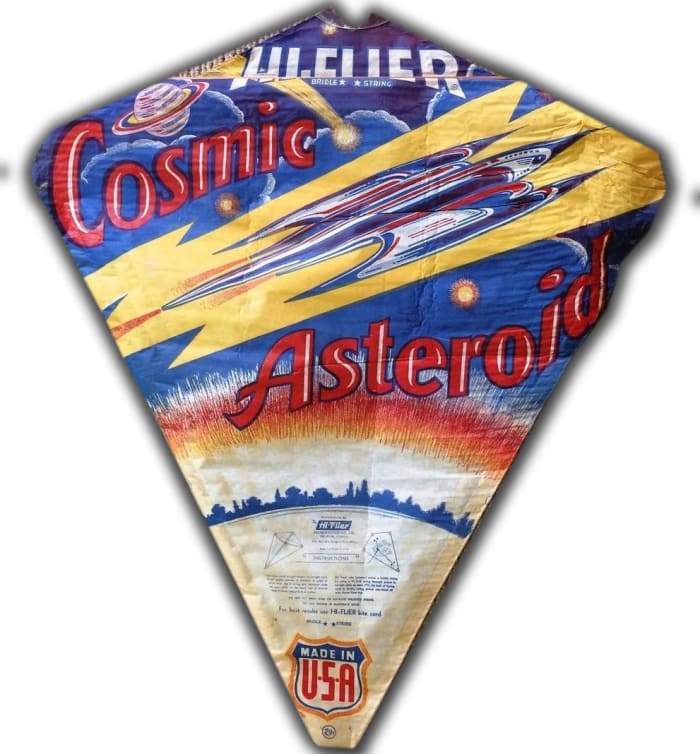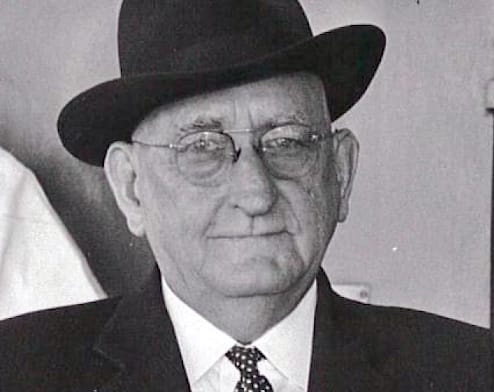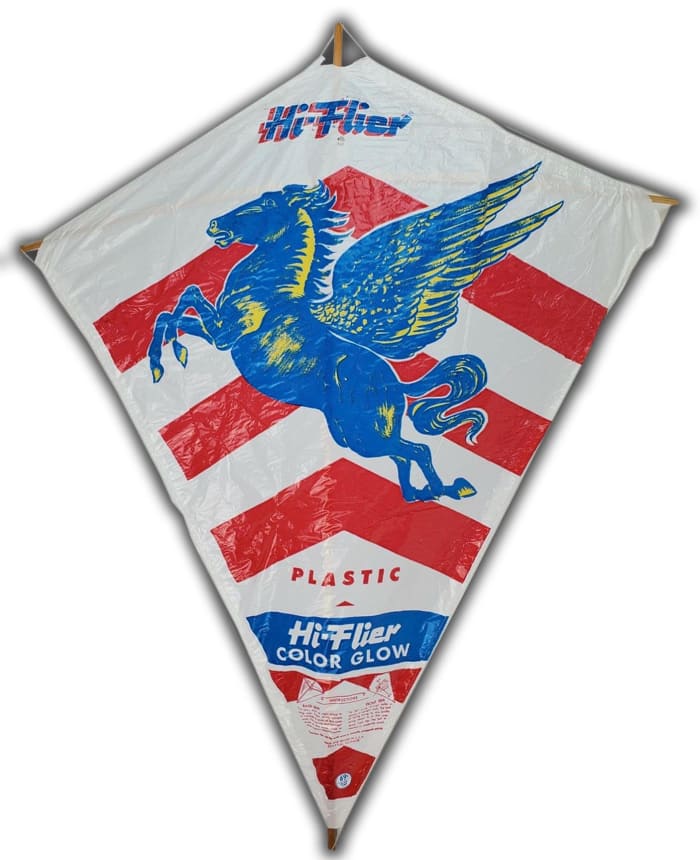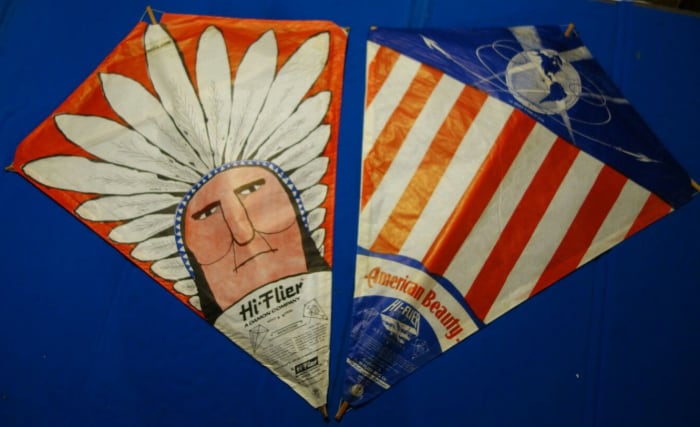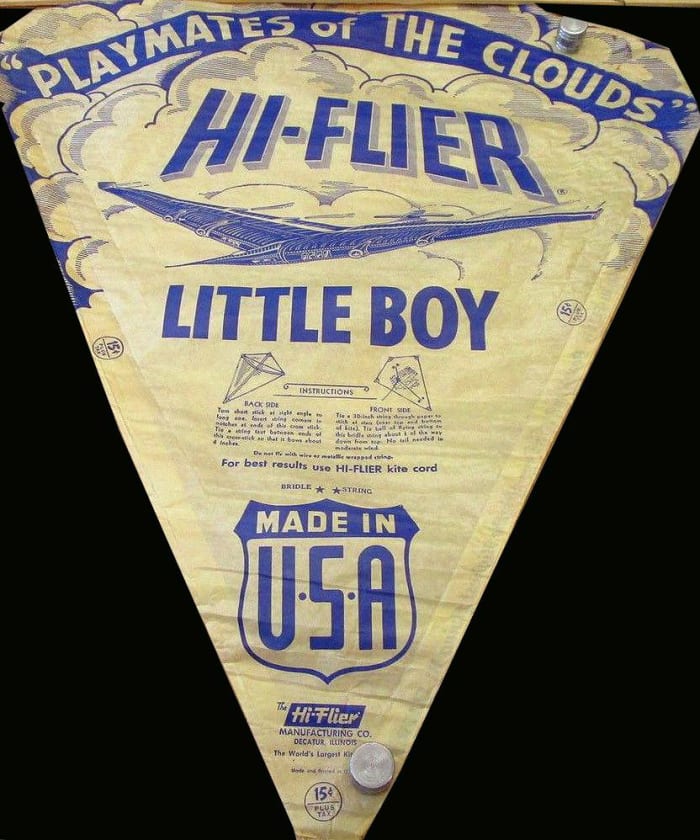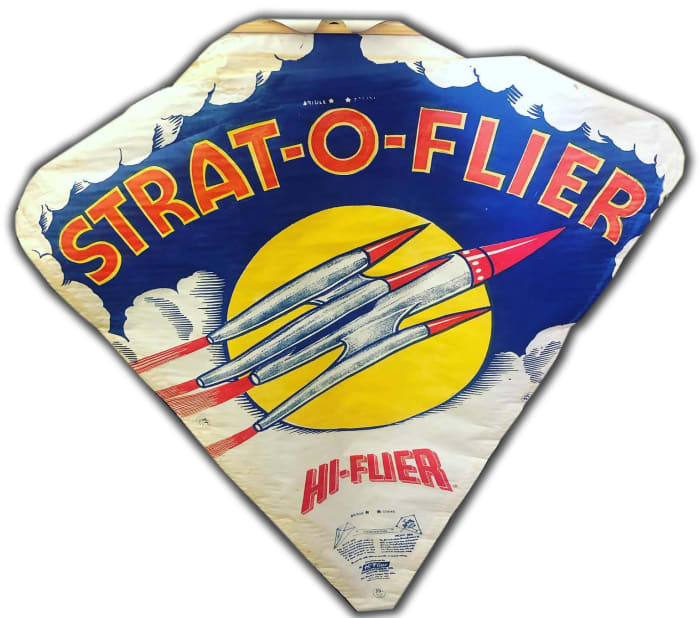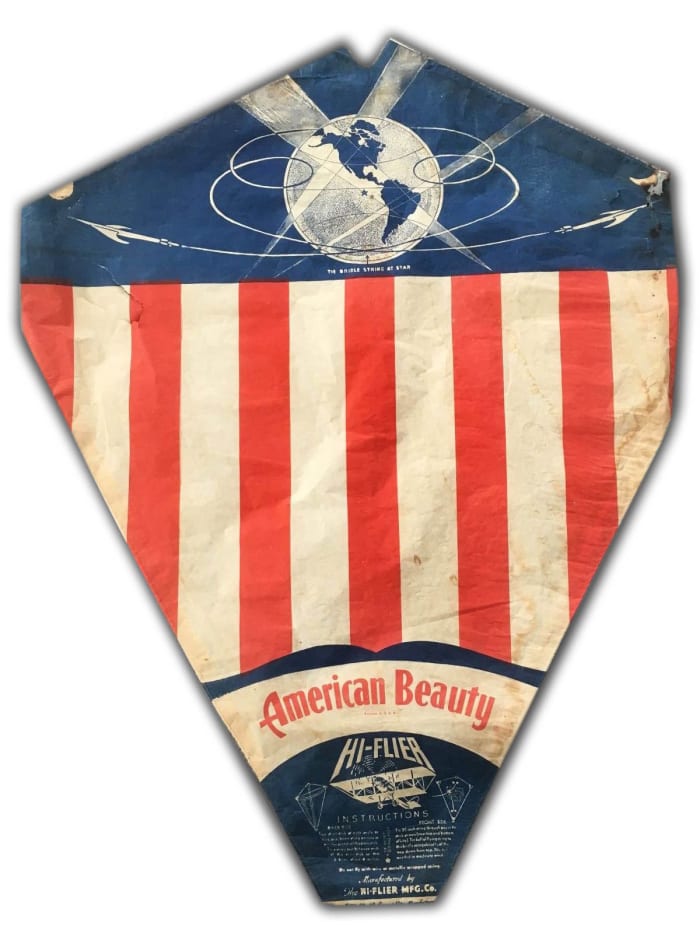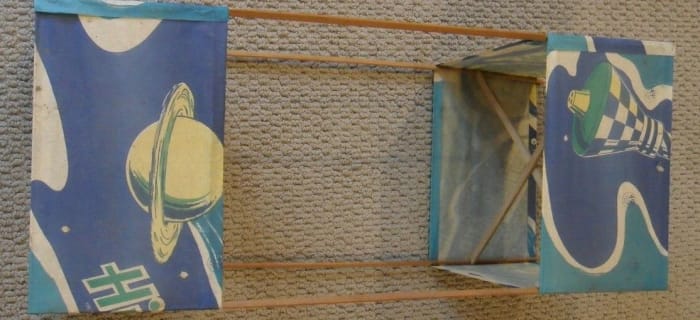Ask me what I know about Decatur, Illinois, and I’ll tell you that that’s where Hi-Flier kites come from. Came from, at least, in the era when I was an ardent consumer of kites. This was from about 1960 to 1966, roughly when I was in second through eighth grade, on the Northwest Side of Chicago, near Talcott Road and Canfield, right on the border with Park Ridge.
I say “consumer” of kites because that’s how it worked: I saved up a dime, bought a kite down at Bud Maday’s Talcott Hardware Store at Talcott and Canfield, and flew it until I destroyed it, which was anywhere from five minutes to five days after standing up in the Edison School playground and committing my doomed possession to the Windy City’s erratic winds. The poor kites were doomed because we flew them too near the trees that grew in the parkway around the schoolyard, we flew them in winds too strong for the string we had, and we flew them with second-hand string that other kids had left lying around in the damp grass.
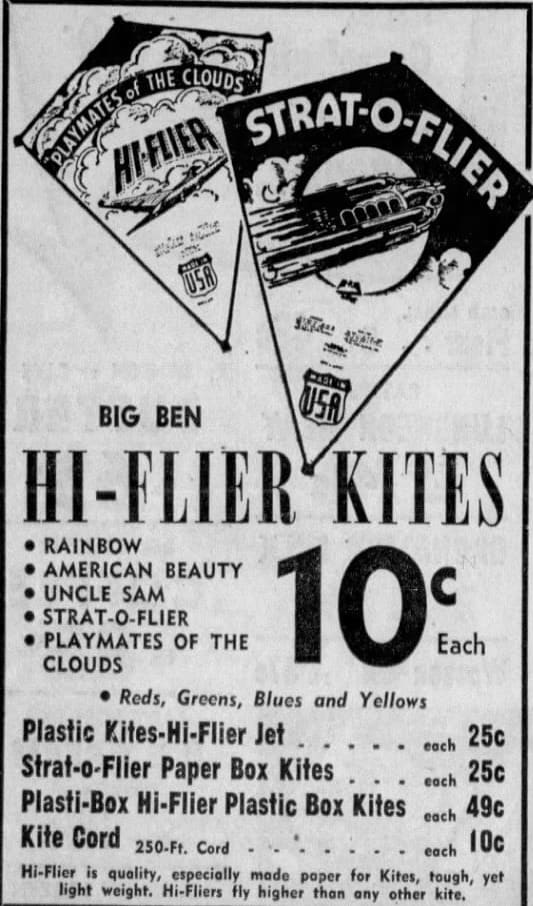
An early ad for Hi-Flier kites in the Herald & Review, Decatur, Illinois.
Image courtesy Herald & Review
As for Hi-Flier kites, well, we flew them not because of any strong brand loyalty, but because that’s what Bud stocked in his hardware store, and Talcott Hardware was the closest source of kites we had. I knew of TopFlite kites, and Alox kites, but those could only be had at exotic places like Walgreens and S. S. Kresge’s that you had to take a car to get to. Bud passed away in 2005, and his children decided to close the store in the summer of that year, after 55 years in business. I was honored to receive the last kite to go out the door at Talcott Hardware, though it was not a Hi-Flier.
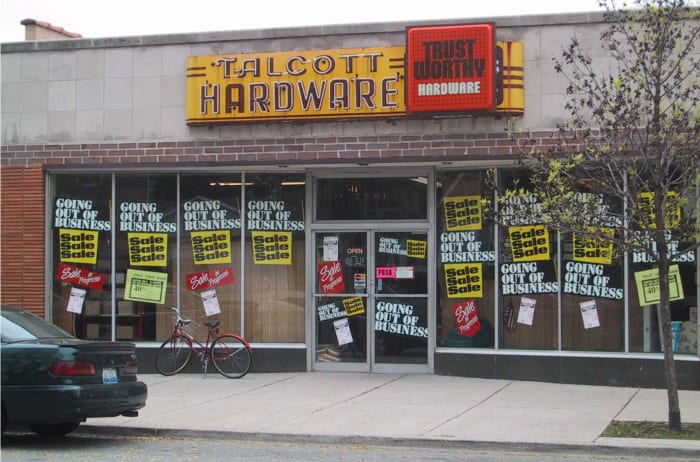
The author and other kids scrambled to Talcott Hardware Store for their Hi-Flier kites. The store closed in 2005.
Image courtesy Jeff Duntemann
I’ve often wondered what Decatur is like, now and 55 years ago when I was a Hi-Flier customer. As a kid I always envisioned a small town with a brick main street out in the Great Nothing of the central Illinois prairies, with a railroad track and grain elevators on the far side of town, and a very wide sky that always had a few kites in it. That was my Chicago big-city bias showing. Decatur is not really a small town – it’s population is right around 72,000 – and it is certainly not a farm town. It was home to a great deal of manufacturing in the Smokestack era of the American Midwest.
RELATED: The Rise And Fall of Hi-Flier Kites
Harvey A. Sellers (1889-1976) started the Hi-Flier Manufacturing Company in his Decatur home. He got started by purchasing a patent to a bow kite from a Decatur inventor named Arthur W. Cash and later that same year patented a barn-door kite in his own name. These two kite designs were the core of his business while production remained in Decatur. Hi-Flier later obtained a patent on the Hi-Flier box kite. The bow kite patent date (1923) was printed on virtually every Hi-Flier bow kite ever made, and a lot of supposedly savvy antiques people believe that this indicates when the kite was manufactured. Not so. Most surviving Hi-Flier kites date back to the late 1950s at best. I’ve seen only a few older ones.
Hi-Flier did very well, and was selling twenty million kites a year at a time when there were only seven million kids of kite-flying age in the country. Sellers understood the nature and economics of paper kites when he said “… a kite not caught in a tree is like an ice-cream cone not eaten.” By making them inexpensive, he knew his little “consumers” would just go back to the dime store and buy another when the trees took their inevitable due.
Hi-Flier as a brand name is still alive, but the company in Decatur is long gone. Needham, Massachusetts-based Damon Corp. bought Hi-Flier in 1971. The Decatur plant was shuttered in 1981 and Hi-Flier was consolidated with Damon at the company’s Estes Rocket Division in Penrose, Colorado, closing the Decatur business after 60 years. At the time, a company official said Hi-Flier hadn’t made a profit since 1974, despite selling an estimated six million kites in the 1980 season, according to a Decatur Herald & Review story.
The paper kite business in general is long extinct. Even the advertising/promo kites that used to be Hi-Flier’s bread and butter are now made of plastic somewhere else (generally China) and fly poorly if they fly at all. (There’s one exception: The RB Toy Development Company’s “Giant Kite,” which many of us saw as the “Green Giant kite” during periodic box-top campaigns for frozen veggies as long ago as 1987. They flew beautifully, though they have not been made for quite a few years.)
There were three different types of kites in the Hi-Flier canon during the time I flew them, which was roughly 1958 through 1970. Two are well known, and the third I saw only once in that time period, in (I think) 1966:
The classic two-stick diamond bow kite made in three sizes and two materials. The two smaller sizes sold in paper for 10 cents, and a larger size in paper sold for 15 cents. The smallest size was also available in plastic, for a quarter.
The paper box kite, a cantankerous, fragile, and short-lived beauty costing 50 cents at that time.
The three-stick, six-sided “barn door’ flat paper kite, a rare oddity I have little experience with.
Later on, Hi-Flier produced a number of interesting kites, all of them in plastic. By the early 1980s, plastic delta kites had become the rage, and paper bow kites gradually went into eclipse. Keep in mind that after the Decatur operation ceased and “Hi-Flier” was reduced to being a brand name licensed to other toy manufacturers, the name was applied to lots of other species of toys, including marbles and yo-yos.
The Hi-Flier diamond kites came in three sizes, specified by the length of the long (vertical) stick:
• Small: The vertical stick was 29 1/4″ and the bow stick was 23 3/4″.
• Medium: The vertical stick was 36″ and the bow stick 29 1/4″. Note that the bow stick of this size was the same as the vertical stick in the small size.
• Large: The vertical stick was 42″ and the bow stick 36″. Again, the bow stick was the same size as the long stick in the next smaller size. This allowed Hi-Flier to make three different sizes of kites with only four sizes of stick.
THE SMALL KITES (30″)
The small paper diamond kites cost 10 cents when I was flying them. (They later went up to 15 cents, and before the end of the Hi-Flier era, 49 cents.) These were my favorites. Two coke bottles found in an empty lot could be returned at the C&T Certified at Canfield and Talcott (around the corner from Bud’s hardware store) and generate funds to buy one. The price went up after I got out of grade school, and in fact the American Beauty kite I have hanging on my wall carries the price 49 cents, meaning it must have been manufactured as late as the mid-1970s. The small kites were the best flyers of anything in the Hi-Flier product line.
The bulk of the small kites that I flew were the “Playmates of the Clouds” design, which may well have been the commonest Hi-Flier art design of that period. The artwork had a futuristic flying wing aircraft in the center, below the Hi-Flier logo. Below the aircraft there was sometimes a number (generally 30, though I recall other numbers including 6 and 94), sometimes the words “Little Boy,” and sometimes nothing at all.
The Playmates of the Clouds kites came in a wonderful variety of colors, though the art design was almost entirely identical. Here are the color schemes I have seen – I’m guessing there are more:
• Black on Red paper
• Black on White paper
• Black on Yellow paper
• Green on Light Yellow paper
• Green on White paper
• Dark Blue on Light Blue paper
• Dark Blue on Red paper
• Dark Blue on Light Yellow paper
• Light Blue on Light Yellow paper
• Magenta on White paper
• Red on White paper
• Orange on White Paper
• Orange on Light Yellow paper
The Strat-O-Flier and the Cosmic were two other designs that I’ve seen in the 30″ size, but many or most of the advertising promo kites were of this size as well. The Rainbow design was unusually good, though I never saw it “in the field.” The Rainbow design was also used in the barn door kites late in the barn door era.
At the very end of the paper kite era, in the mid-to-late ’80s, Hi-Flier was doing some interesting art designs in the small kite size. One was a third expression of the American Beauty design, but with a WWI-era biplane in the foreground, and clouds intermingling with the stars. Another, clearly by the same artist, showed similar biplanes in a dogfight. The small-format paper kite appears on a single page of the 1987 Hi-Flier catalog, the lone survivor in an otherwise plastic kite world.
The small Hi-Flier diamond kites were absolutely wonderful flyers. In most Chicago winds that we dared fly in, they would fly tailless with very little trouble. Like any other skill, kite flying took practice, and a certain amount of study. (I took all three kite books out of out local public library repeatedly.) The small kites were wonderful “trainers” because they were inexpensive and if you wrecked one, you learned what you could from the experience, hunted up another couple of bottles, and bought another.
THE MEDIUM KITES (36″)
For a while the medium-sized diamond kites were also 10 cents at Bud’s Talcott Hardware, but they went up to 15 cents by the time I was in high school. The most common and, in my opinion, the most beautiful and effective design was the American Beauty. Lots of kids were flying them on and just after the Fourth of July. They had a globe on a blue field at the top, with red and white strips below, and the legend “American Beauty” in red on white below the stripes. This always has been my favorite Hi-Flier graphics design, and I am proud to own a mint specimen.
Another older design I have seen only occasionally on eBay had the Playmates’ “flying wing” aircraft but little else, and the legend “Big Ben” at the kite’s center. This kite is almost identical to the 42″ “Big Boy” kite with the same Playmates flying wing aircraft and the same slightly silly tagline “Tailless Dancing Kite.” (This last seems to have been an early Hi-Flier slogan, but I don’t remember seeing it during my own kite days.) I’ve seen bow kites dance, but when they do, it usually means you don’t have the bridle set up correctly!
I’ve seen a few promo kites in the 36″ size, though most of them (especially late in the paper kite era) were 30″ in size.
THE LARGE KITES (42″)
I don’t remember these as well, because I only flew a couple. I have seen an older kite in red with the legend “Big Boy” that was the size of the large kites that I flew, but it must have been a little before my time. There was a plastic Color Glow kite in the 42” size, in several Day-Glo colors including green and orange. I have one, but I don’t know for sure when it was made. The most recent (1976) of the large kites that I can reliably date is the plastic “Big Bruno,” showing a circus strongman holding up dumbbells that are … balloons! Like the Silly Face and Pirate designs, artist Harry Gans, who created a lot of the late Hi-Flier designs, drew Big Bruno.
One of my friends preferred the large kites (which at that time cost 15 cents and soon afterward 25 cents) and looked down his pointy nose at my (small by comparison) American Beauties. He was smart, and figured out (as most kids never did) that a bigger kite would fly in less wind. I didn’t like them because they cost another redeemed bottle to buy, and once in the air it was impossible to tell that they were any bigger than my Playmates of the Clouds. And at the rate I wrecked kites (and with plenty of competition for scavenged bottles) the extra nickel seemed an unwarranted waste.
THE PLASTIC BOW KITES
These cost a quarter when I flew them (later 29 cents and later still $1) and when I had quarters—which wasn’t often—I bought better things than kites. I remember flying a couple with my cousin Ron down in Blue Island. Ron had the best toys, including the biggest Erector set I ever saw. The most common design for plastic bow kites was a Flash-Gordon style spacecraft with the legend “Orbiteer.” There were two overall color schemes, blue and magenta. The Orbiteer design was rearranged and freshened up a little in the late 1960s, when the slogan “Color-Glow” was added to all Hi-Flier’s plastic bow kites. Plastic kites were made in all three of the standard kite sizes.
A less common Color-Glow design in plastic was the Pegasus kite, showing a flying horse against a striped background, in either red or blue. Hi-Flier promo kites in plastic exist but are rare. (I’ve seen only one, for Dutch Boy paints.)
The earlier plastic bow kites had two small metal grommets set into the plastic sail for the bridle string. Later plastic bow kites lacked the grommets, and the plastic was simply punched at the two bridle attachment points.
By 1977, virtually all Hi-Flier kites were made of plastic. This was not entirely because they were cheaper for the company to make, though I’m sure that was a factor. They were rugged. It took more than one dive into the bushes to shred one, but somehow I was never good at economics and didn’t do the math, even though I might have come out ahead had I gotten in the habit of hoarding a few more bottles and thinking, “Plastic!”
THE BOX KITES
I lusted after these, and every so often (usually after Aunt Kathleen had given me a dollar for no good reason) I would buy one. In the period I was flying them they had a very simple art design: colored paper (usually green and white) with relatively small drawings of jet aircraft, helicopters and things. The physical design was diabolical: Each end was kept at very high tension by two cross-sticks that were slightly too long to fit inside the paper box portion, and had to bow a little. The paper was thus tight as a drum, and tore easily. (This may be why I don’t see many assembled ones on the auction sites. Nobody wants to risk destroying a vintage kite that might fetch fifty bucks!)
There was a drawback to the box kite: They flew like demented birds of prey, swooping and zipping around at incredible speeds, pulling tremendously hard, almost always on the edge of being out of control. Flying one was the first adrenaline rush I can clearly recall. Each represented a lot of kid capital, and having seen plenty of them die at other kids’ hands, there was a lot of anxiety in trying to get them to rise and sit still.
Sit still? Hah. No chance. Not even by me, who considered his twelve-year-old self a Kite Master. In the strange divided drafts that beset the too-small Edison schoolyard, they flew like crazed eagles, often for no more than a few seconds before diving full-speed straight down from seventy feet in the air and exploding into sticks and shreds in the muddy spring grass.
The box kites were sold from the early 1950s well past the time I was flying kites from Bud’s Hardware Store, and I don’t know when they went out of production. They must have been fairly expensive to make, and they had a bad rep among kids for their habit of self-destructing. They were gone from the Hi-Flier catalog in 1977 and possibly before.
THE BARN DOOR KITES
Barn door kites are the rarest of all the early Hi-Flier kites, and I have never had the honor of flying one. In fact, I saw exactly one specimen in the field, in the hands of a boy near my parents’ summer home at Third Lake, Illinois, in ’65 or ’66. The kite was quite small, and the poor kid had no luck getting it in the air. He told me he got it free when his dad bought him a pair of shoes in Grayslake.
The barn door kites were flat kites. They had three sticks, not two: an “X” of two sticks 23-1/2″ long, with a single 16″ stick crossing them at the center through a metal staple. There was no bow, though barn-door kites with a bow in the horizontal stick are possible and should fly well.
I suspect that the barn door kites weren’t popular with kids because they took a fair amount of careful rigging: three separate bridles that had to meet above the kite’s dead center. They also required a tail — and without sufficient tail, my guess is that they lasted maybe ninety seconds in clumsy 9-year-old hands.
PROMOTIONAL KITES
I didn’t know it at the time, but Hi-Flier must have done a tremendous business in promotional kites, by which I mean the small-sized two-stick paper kites on which a business would have Hi-Flier print its company advertisement or other design and give them to kids as promotional items. Jif peanut butter, Sinclair and Texaco, Studebaker cars, Burger King, AC spark plugs, various local businesses and radio stations; it’s amazing.
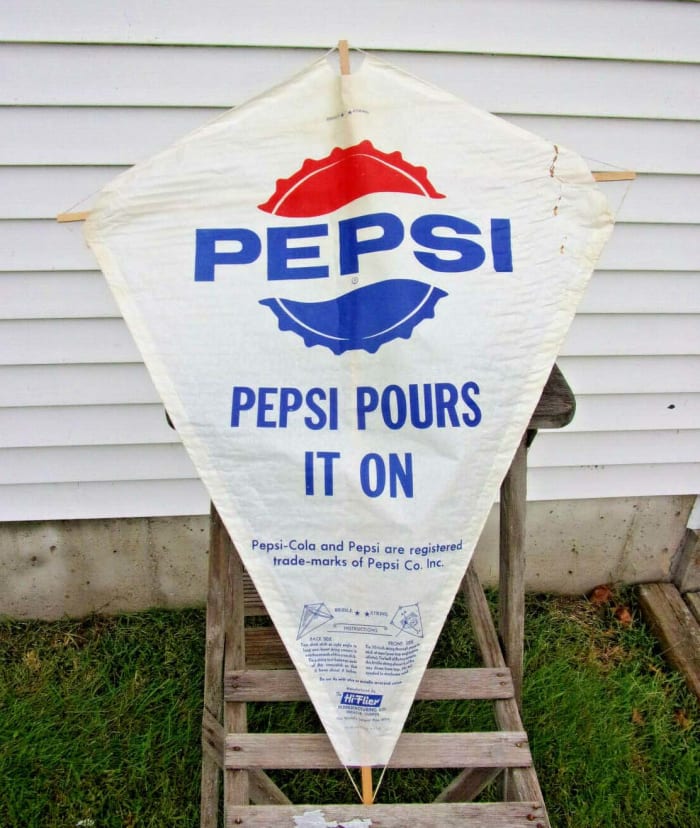
A Hi-Flier Pepsi promotional kite from the 1960s.
Image courtesy Brady’s Bunch of Lorain County Nostalgia
Promo kites were made into the late 1970s (or possibly the 1980s) and were probably a big profit center for the company. The promo kites exist in both 30″ and 36″ sizes, but most that I have seen are 30″. I have seen only one plastic Hi-Flier promo kite, for Dutch Boy paints.
My wife received a Big Boy Fan Club kite at a Big Boy restaurant in 1973 that rested in my mother-in-law’s basement rafters for thirty years before we pulled it out and flew it in 1995. It survived the flight and now belongs to our nephew, who has flown it several times and miraculously still has it!


